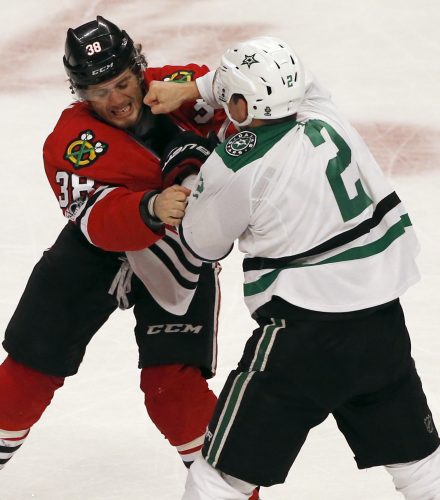 With 14 minutes remaining in the second period, Darrin Madeley, goaltender for the Detroit Vipers in the International Hockey League, gets his legs swept out from under him, taking him down, knocking him unconscious and leaving him with his fourth of seven career concussions. That was in 1995. Twenty two years later, concussions are still an unsolved problem within professional hockey.
With 14 minutes remaining in the second period, Darrin Madeley, goaltender for the Detroit Vipers in the International Hockey League, gets his legs swept out from under him, taking him down, knocking him unconscious and leaving him with his fourth of seven career concussions. That was in 1995. Twenty two years later, concussions are still an unsolved problem within professional hockey.
According to a study done by the Canadian Medical Association Journal, during a seven-season span from 1997-2004, team physicians reported a total of 559 concussions during regular season games in the National Hockey League (NHL).
“(I have had) seven (concussions), six where I have been knocked out,” Madeley said. “They used to say, ‘You got your bell rung,’ and you just shook it off and kept playing, but I don’t think they understood enough about it back then.”
Currently, the NHL Concussion Protocol requires mandatory removal of a player from play for an acute evaluation as soon as possible if a concussion is suspected followed by a resting period until symptoms diminish and a post-concussion neuropsychological evaluation before the player can return to the ice.
“I think everyone is aware of (the problem) and (are) certainly trying to minimize concussions,” Chicago Wolves athletic trainer Kevin Kacer said. “I think we are heading in the right direction. We are more aware of it now than we were 15-20 years ago.”
Currently, the American Hockey League (AHL) follows the same concussion protocol as the NHL.
While the protocol is an improvement from the “play through it” approach that was used in the past, players are still experiencing the consequences of concussions.
Research done by the Toronto Star found that at least 30 players since 1996 were forced to retire due to concussions.
“Even just talking (I) can feel a ringing noise,” Madeley said of the long-term impact of his concussions. “There are times where (I’d) just feel like (I was) out of breath and it didn’t make any sense.”
Madeley says he still struggles with post-concussion symptoms and he’s not alone.

In 2015, former NHL defenseman Steve Montador committed suicide at the age of 35. Upon further review of Montador’s brain by the Krembil Neuroscience Centre in Toronto, it was discovered that he suffered from chronic traumatic encephalopathy (CTE), a neurodegenerative brain disorder linked to repeated concussions.
The concussions “had significant impact in terms of memory loss, thinking, decision-making — all kinds of things that were difficult for him near the end of his life,” said Montador’s dad Paul, in an interview with the Chicago Tribune. “He would forget things within minutes, and he knew it. He realized it. He was trying to relate it to the concussions or depression or whatever was causing those things.”
The Montador family plans to sue the NHL. Currently, more than 100 retired players have brought a class-action lawsuit against the NHL over the brain injuries experienced while playing. The lawsuit claims that the NHL knew more about the link between hockey and concussions than they let on and didn’t properly inform or educate its players about the risk. In the midst of this, NHL commissioner Gary Bettman continuously denies the link between concussions and CTE.
There have been many different discussions surrounding the issue of concussion management. Not too long ago, people were debating whether or not eliminating fighting would show a decrease in head injuries.
The debate is a reasonable one considering the deaths of NHL enforcers Derek Boogaard, Wade Belak and Rick Rypien.
Boogaard, who died in 2011 from an accidental drug and alcohol overdose at the age of 28, was involved in 114 fights during his time in the NHL and AHL according to hockeyfights.com. Upon further examination of his brain after his death, it was determined that Boogaard was suffering from CTE.
Belak and Rypien were involved in 136 and 71 fights, respectively, during their professional careers, according to hockeyfights.com
The three players all died within four months of each other. Belak and Rypien were both found dead in August of apparent suicides and had been known to be struggling with clinical depression.
Another debate surrounding the concussion issue is safer equipment.
According to a study done by Virginia Tech, most helmets were determined unsafe. On a five-star scale rating, no helmet received four or five stars. Twelve received zero stars and were labeled “not recommended.” Only three helmets received three stars and the rest earned either one or two stars.
In a recent step forward, the NHL implemented a new tactic of concussion spotters, both central and in-arena.
The spotters are certified athletic trainers who have clinical experience working in elite level hockey, and have received training on the visible signs of concussion in the protocol.
“It’s always good to have an extra set of eyes watching a game,” Kacer said. “I’ll be honest, there are times when I miss something. I’ll be watching the puck and the play near the puck and something could happen well behind the play and I don’t see it.”
According to a press release sent out by the NHL, the staff of Central League Spotters will monitor all games from the player safety room in New York and will be authorized to require a Player’s removal from play for evaluation for concussion if the player exhibits certain visible sign(s) under the protocol, following a direct or indirect blow to the head.
If a team refuses to remove a player for evaluation they must pay a “mandatory minimum fine” for their first offense and a “substantially increased fine” for each additional offense.
“[The spotters are] good because those are people who are not associated with the team,” Madeley said. “I think that’s huge because if you have somebody on the team and there’s somebody in management or a coach that can manipulate that system, then you’re never going to have an honest assessment.”
While the NHL is making slow improvements, organizations are starting to emerge that offer support to retired players struggling with the transition or suffering from mental illness.
Most notable is the Chapter 5 Foundation, started by former Chicago Blackhawk Daniel Carcillo.
As a close friend to Montador, Carcillo, in an emotional video for The Players Tribune describes watching his friend deteriorate.
“Seeing the number of sets of keys he had for the same lock kind of tells you the story of what was going on in his head with his memory loss and mental state,” Carcillo said.
Chapter 5 is described as “a not-for-profit that will help athletes find a new purpose and transition into life after the game.”
“I think it’s a great resource to have and, yes, I think there should be more resources like that available to players,” Kacer said. “Unfortunately now when a player retires it’s like ‘see you later, good luck’ and they don’t have health coverage after and it’s tough.”
But Kacer says it’s important for players to take on the responsibility themselves as well.
“A player has got to be honest with the trainer and the doctors if he is having symptoms. (A player has) a life to live outside of hockey(…) there’s only so many years that they are going to play hockey and they’ve got a lot more years of life ahead of them and they’ve got to prepare for that.”

